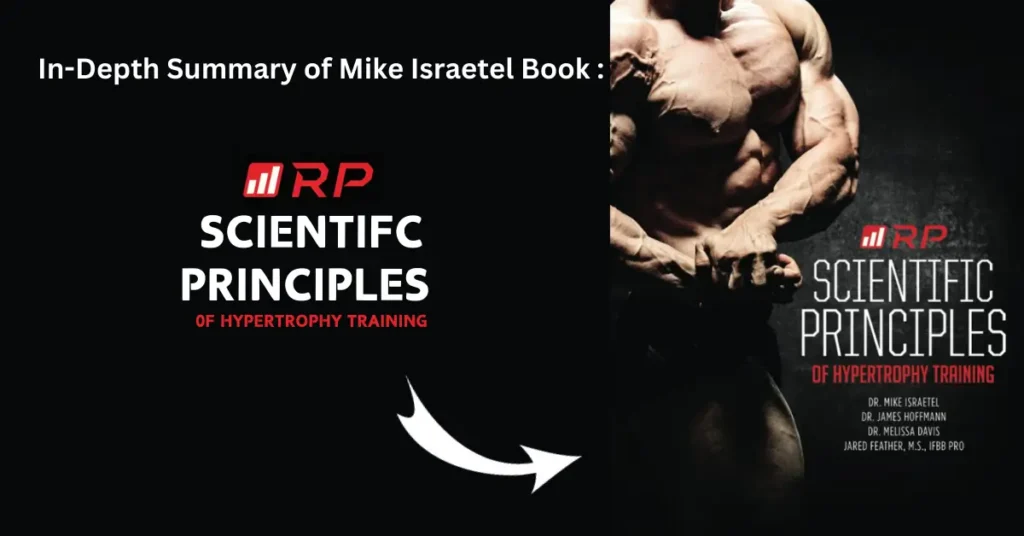Scientific Principles of Hypertrophy Training Book Summary
Dr. Mike Israetel’s 377-page book, Scientific Principles of Hypertrophy Training, provides a clear, science-based guide on how to build muscle through progressive overload, how much to train, understanding muscle types, and much more.
This book is designed for advanced readers and goes into detail about the science of muscle building, making it perfect for those who want to understand training at a higher level.
Table of Contents
The Authors of the Book:
- Dr. Mike Israetel
- Dr. James Hoffman
- Dr. Melissa Davis
- Jared Feather (IFBB Champion)

Key Points of the Book:
1. For Beginners:
- Start with simple exercises to avoid injuries.
- Focus on big, compound exercises (like squats or bench presses) instead of isolated ones (like bicep curls).
- Avoid doing cardio before weightlifting, so you have enough energy for your workout.
2. Progressive Overload:
- Slowly increase the difficulty of your workouts over time.
- Add more weight, do more reps, or hold the weights longer to help your muscles grow.
3. Volume and Frequency:
- The best range for reps is 8–30 per set, depending on the muscle type.
- Heavy weights with fewer reps are good for muscles like thighs and chest (fast-twitch).
- Light weights with more reps are better for muscles like arms and abs (slow-twitch).
- Train each muscle group for about 12 sets in a session, twice a week.
4. Training Effectiveness:
- Muscle Tension: Pay attention to how your muscles feel during exercise like the pump or burn.
- Reps in Reserve (RIR): Stop when you still have 2–5 reps left in the tank. This avoids overtraining and keeps workouts effective.
- Stimulus to Fatigue Ratio (SFR): Don’t do too much. Overloading with too many sets can reduce how effective your training is.
5. Avoiding Junk Volume:
- Doing too many sets lowers the quality of your training and makes it harder to recover.
- Focus on workouts that balance effort and recovery for better muscle growth.
Important Key Elements of Exercise from the Book
In this book, the authors provide a detailed guide on the important aspects of a good exercise. You should focus on these points:
- Velocity: The speed at which you perform the movements.
- Loading: How much weight you use during exercises.
- Volume: The total number of reps and sets you do.
- Training Methods: Techniques like myo-reps, drop sets, and others.
- Exercise Order: The sequence in which you do the exercises.
These are quick explanations. If you want to read more, be sure to check out the book.
Let’s Discuss the Important Points of the Book in more Depth.

Chapter 1: The Importance of Specific Goals
In the first chapter, the authors explain that a clear and specific goal is very important. When you want to improve in areas like strength, muscle growth (hypertrophy), or endurance. For example, if your goal is to improve your squats, focusing on squat exercises with weights is a specific goal and a good approach. However, creating a broad goal like “lunges,” which includes many different types of exercises, can make it harder to focus on your real goal.
Another example: If your goal is to grow bigger biceps, but you’re focusing on overall body exercises like working your triceps, shoulders, and back, you might see some benefits, but it won’t be enough to reach your specific goal. So, always prioritize one particular goal at a time.
Debunking the Squat and Milk Myth
The book also discusses a common belief: some people think that doing squats and drinking milk will make your whole body, including your arms, grow bigger. The idea is that squats release testosterone, which helps build muscle, and milk provides nutrients that support size. While this is somewhat true for building strength in your legs, it’s not enough to grow your arms. To make your arms bigger, you need to train them directly with exercises that focus on your arm muscles.

Squats are great for your legs and overall strength, but they won’t directly make your arms bigger. To get balanced muscle growth, focus on exercises that target each muscle group specifically.
Overload: Key Principle of Muscle Growth
In the next section, Dr. Mike focuses on the principle of “overload,” which is important for muscle growth. Many people think that progressive overload just means adding more weight to your exercises. However, the book explains that it’s more than that. Overload can also involve increasing tension, volume, and effort over time. Here are nine important factors for overload:
- Tension: The force you apply to your muscles during exercise.
- Volume: The total amount of work done, including sets and reps.
- Relative Effort: How close you are to failure during your workout.
- Range of Motion (ROM): How far you move your muscles during an exercise.
- Metabolite Accumulation: The build-up of lactic acid during intense workouts.
- Cell Swelling: The “pump” effect you feel in your muscles.
- Mind-Muscle Connection: Focusing on the muscle you’re working on during exercises.
- Movement Velocity: How fast or slow you move during reps.
- Muscle Damage: Small tears in your muscle fibers that repair and grow stronger over time.
Giant Sets and Myo-Reps: Training Methods

The next chapter explains different training methods, including Giant Sets. A giant set isn’t just doing a bunch of pull-ups in one go. It’s about doing several different exercises one after another without resting. For example, you could do squats, lunges, leg extensions, and split squats back to back. This method helps target the same or related muscles and builds endurance and strength.
The book also introduces Myo-Reps, which involves doing 5 to 10 reps in mini-sets. For example, if you’re doing pull-downs and you reach failure after 4 to 5 reps, you should then do 5 to 10 more reps in smaller sets to push your muscles further.
Self-Assessment with Quizzes
The book also includes small quizzes to help you assess how well an exercise worked for you. These quizzes help you rate different aspects of your workout, such as:
- How much you felt your muscles working (the “pump”).
- How well you could focus on the muscles you were using (mind-muscle connection).
- How sore you feel after the exercise.
- How hard the exercise felt.
You score these aspects from zero to three, helping you understand your progress and how effective each exercise is for you.
Honest and Thoughtful Approach
This book is very honest in its approach to fitness. It supports using a full range of motion in exercises and acknowledges that sometimes it might not be the best choice. For example, it explains that high-frequency training (working out the same muscles often) is usually beneficial, but there are times when it may not work for everyone. The authors present both sides of the argument, which is helpful because it encourages you to think critically and make your own decisions.
A good fitness book should make you think more, not less. One important idea the authors emphasize is the mind-muscle connection. This means focusing on how your muscles feel when you’re exercising. You can’t just read about it in a book you need to actually feel it yourself during your workouts.
Conclusion:
Dr. Mike Israetel book ‘Scientific Principles of Hypertrophy Training’ provides a comprehensive, science-backed approach to building muscle, drawing on over 18 years of research and experience. The book covers key concepts such as progressive overload, muscle tension, and optimal volume and frequency, offering a roadmap for smarter, more effective training.
With its focus on specific goal-setting, avoiding “junk volume,” and introducing advanced techniques like giant sets and Myo-Reps, this guide is a must-read for anyone serious about muscle growth. If you are committed to growing your muscles and training at a higher level, I highly recommend purchasing this book, especially if you are an advanced reader.
For more detailed insights and strategies, you can get your copy of Scientific Principles of Hypertrophy Training on Amazon: Buy on Amazon.
Hope you like our article, The Summary of Mike Israetel’s Book ‘Scientific Principles of Hypertrophy Training. If you have any questions or confusion, feel free to comment below.
If you want to know more about Dr. Mike Israetel, check the homepage of this website by clicking here.

I am an SEO blogger and freelancer for the past 5 years. I don’t just write or work for bots like Google or Bing. My writing and other work, like SEO, design and more, are for real users who get real value from it. It is my responsibility to make sure that when a user comes looking for something, they get a complete answer to their query.






